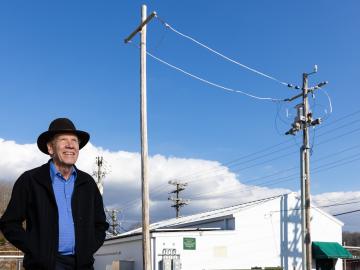
Filter News
Area of Research
- Advanced Manufacturing (2)
- Biological Systems (1)
- Biology and Environment (34)
- Computational Biology (1)
- Computer Science (2)
- Energy Science (46)
- Fusion and Fission (4)
- Fusion Energy (1)
- Isotopes (7)
- Materials (55)
- Materials for Computing (7)
- National Security (14)
- Neutron Science (27)
- Nuclear Science and Technology (4)
- Quantum information Science (3)
- Supercomputing (61)
News Type
News Topics
- (-) Artificial Intelligence (79)
- (-) Biomedical (44)
- (-) Clean Water (17)
- (-) Computer Science (117)
- (-) Materials (53)
- (-) Materials Science (64)
- (-) Microscopy (27)
- (-) Nanotechnology (21)
- (-) Polymers (12)
- (-) Security (18)
- (-) Space Exploration (13)
- (-) Transportation (35)
- 3-D Printing/Advanced Manufacturing (60)
- Advanced Reactors (13)
- Big Data (50)
- Bioenergy (70)
- Biology (82)
- Biotechnology (26)
- Buildings (35)
- Chemical Sciences (37)
- Composites (12)
- Coronavirus (20)
- Critical Materials (6)
- Cybersecurity (14)
- Education (2)
- Emergency (3)
- Energy Storage (37)
- Environment (124)
- Exascale Computing (51)
- Fossil Energy (6)
- Frontier (45)
- Fusion (40)
- Grid (34)
- High-Performance Computing (82)
- Hydropower (6)
- Isotopes (35)
- ITER (4)
- Machine Learning (40)
- Mathematics (9)
- Mercury (7)
- Microelectronics (3)
- Molten Salt (2)
- National Security (63)
- Neutron Science (85)
- Nuclear Energy (71)
- Partnerships (36)
- Physics (39)
- Quantum Computing (35)
- Quantum Science (49)
- Simulation (44)
- Software (1)
- Statistics (2)
- Summit (40)
Media Contacts

A study by researchers at the ORNL takes a fresh look at what could become the first step toward a new generation of solar batteries.

Bruce Warmack has been fascinated by science since his mother finally let him have a chemistry set at the age of nine. He’d been pestering her for one since he was six.

Spanning no less than three disciplines, Marie Kurz’s title — hydrogeochemist — already gives you a sense of the collaborative, interdisciplinary nature of her research at ORNL.

To explore the inner workings of severe acute respiratory syndrome coronavirus 2, or SARS-CoV-2, researchers from ORNL developed a novel technique.

A new version of the Energy Exascale Earth System Model, or E3SM, is two times faster than an earlier version released in 2018.

A team of scientists led by the Department of Energy’s Oak Ridge National Laboratory and the Georgia Institute of Technology is using supercomputing and revolutionary deep learning tools to predict the structures and roles of thousands of proteins with unknown functions.

Neuromorphic devices — which emulate the decision-making processes of the human brain — show great promise for solving pressing scientific problems, but building physical systems to realize this potential presents researchers with a significant

The world is full of “huge, gnarly problems,” as ORNL research scientist and musician Melissa Allen-Dumas puts it — no matter what line of work you’re in. That was certainly the case when she would wrestle with a tough piece of music.

Burak Ozpineci started out at ORNL working on a novel project: introducing silicon carbide into power electronics for more efficient electric vehicles. Twenty years later, the car he drives contains those same components.

Energy Secretary Jennifer Granholm visited ORNL on Nov. 22 for a two-hour tour, meeting top scientists and engineers as they highlighted projects and world-leading capabilities that address some of the country’s most complex research and technical challenges.


